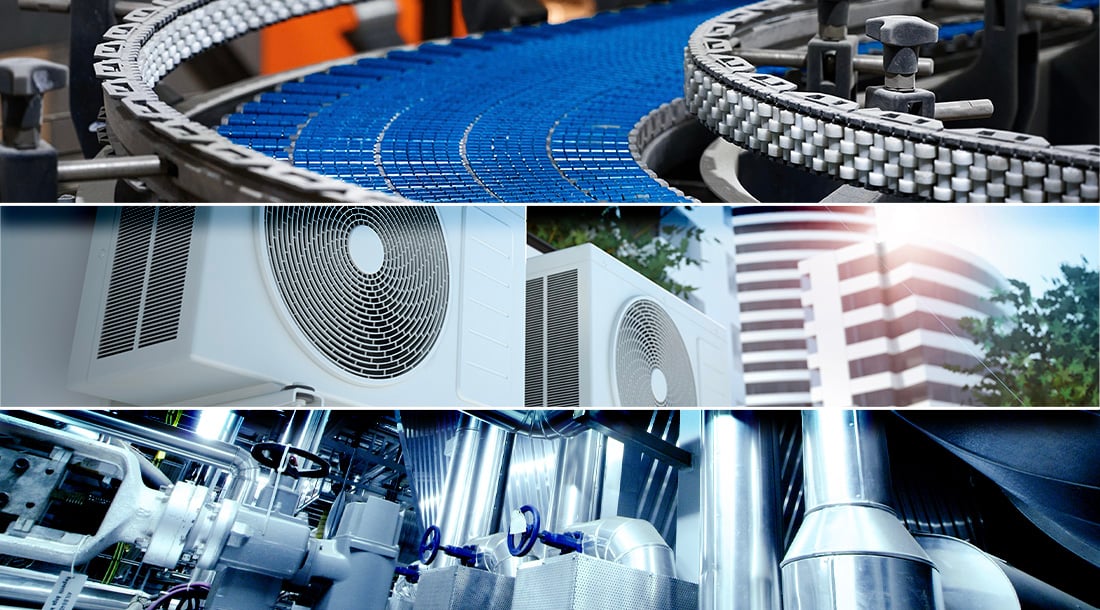
What is a Variable Frequency Drive (VFD)?
Looking for ways to reduce energy consumption and costs? You’re not alone. But, regardless of your industry or application, chances are a variable frequency drive (VFD) can help you.
Let’s take a closer look at what VFDs are, the basics of how they work, and what industries are using them to lower energy costs.
What is a VFD?
A variable frequency drive is a type of motor drive that controls the speed of an AC motor by varying the frequency and voltage supplied to the motor. VFDs have a variety of other names, including variable speed drives, AC drives, and inverters, among others.
By varying the frequency, VFDs can either increase or decrease the speed of a motor to meet the speed requirement for the equipment or function. Adjusting motor speed can provide a variety of benefits, including improved energy efficiency, reduced mechanical stress, lower noise levels, and more.
Components of a VFD
VFDs consist of three main components. Let’s look at the function of each.
AC to DC Converter (Rectifier)
The converter, also called the rectifier, uses diodes to convert three-phase AC into DC. In a standard six-pulse VFD, there are six diodes: one for each of the A-, B-, and C-phase, as well as three on the negative side of the bus.
The diodes will open and close based on the voltage of each phase; for example, if A-phase voltage is greater than that of B- or C-phase, the A-phase diode will open, allowing current to flow. This results in six pulses of current as each of the diodes opens and closes.
DC Bus
The DC Bus (or DC filter) is composed of a series of capacitors and resistors that buffer and filter the DC voltage coming from the converter, creating smooth DC voltage across the capacitor bank.
DC to AC Inverter
Put simply, the inverter converts DC back to AC. However, the way this happens in a VFD is highly sophisticated.
VFDs utilize pulse width modulation (PWM) technology to control a motor’s speed. In the most basic terms, a series of Insulated Gate Bipolar Transistors (IGBTs) act as switches that, when turned on and off at a controlled speed and sequence, control the phases and frequency of the input signal and output it as a PWM signal, which is what allows the VFD to control motor speed.
Industries that Utilize VFDs
VFDs are used in many different industries, most commonly for controlling fans, pumps, compressors, conveyors, and mixers. For example, HVAC systems are a common application for VFDs, as the drives can help optimize energy consumption and lower energy costs.
Industries that commonly utilize VFDs include:
Manufacturing: VFDs provide a variety of benefits for industrial manufacturers, including improved efficiency and reduced maintenance costs. They’re often used to control conveyors, mixers, and other types of equipment. VFDs can be found across many subsets of industrial manufacturing, including food and beverage, automotive, textiles, and more.
Water and Wastewater Treatment: Like industrial manufacturing, water and wastewater treatment facilities utilize VFDs, often on pumps, to optimize energy consumption and reduce maintenance demands and costs.
Oil and Gas: Being that oil and gas applications are reliant on pumps and pumping systems, VFDs are commonly used to create energy savings, optimize process efficiency, and extend equipment lifespan.
Agriculture: VFDs are commonly used in irrigation systems to control pressure and flow rate. This helps maximum yield while conserving both water and energy.
Find the VFD for Your Application Today
VFDs are highly sophisticated devices designed to save your business money — whether through lower energy costs or reduced maintenance.
Crescent Electric carries a wide range of VFDs, ensuring you’ll find one for your application. Start saving today with VFDs from Schneider Electric, Eaton, Emerson, and more — shop now or visit our sustainability and energy management page for more tips on how to reduce energy costs!